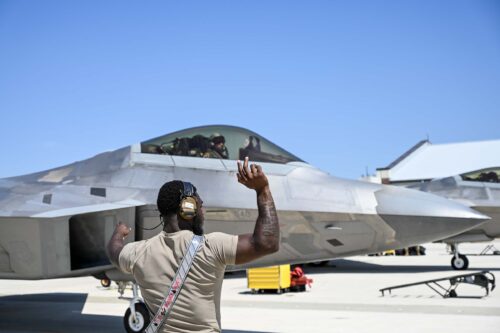The 71st Fighter Squadron, a part of the esteemed 1st Fighter Wing, has recently achieved significant milestones in its operations. Notably, the squadron is currently engaged in training its inaugural group of F-22 student pilots through an intensive nine-month Basic Flying Course. This training program aims to equip the pilots with the necessary skills to effectively employ the F-22, marking a crucial step towards maintaining air superiority for the United States.

U.S. Air Force photo by Tech. Sgt. Ceaira Tinsley
Having undergone rigorous academic instruction and simulator training, the six future F-22 pilots enrolled in the course are immersing themselves in a multi-phased training approach. The program’s methodology combines academic studies, simulator practice, and in-flight instruction to ensure comprehensive preparation for real-world combat scenarios. The training takes place at Joint Base Langley-Eustis, the home of the 71st Fighter Squadron.
To ensure the highest quality of education, students undertake three months of academic instruction and familiarize themselves with the F-22 in simulators and classrooms at Tyndall Air Force Base, Florida. The collaboration between the instructors at the 71st Fighter Squadron and Tyndall AFB ensures a seamless learning environment despite geographical separation.
Upon returning to Joint Base Langley-Eustis, the pilots embark on the flying portion of the program, which encompasses four distinct phases: transition, advanced handling characteristics, basic fighter maneuvers, beyond visual range intercepts, and air combat tactics. The training phases build upon one another, equipping the student pilots with the skills necessary to become proficient F-22 operators and air dominance professionals.
In addition to technical proficiency, the 71st Fighter Squadron places great emphasis on fostering a sense of camaraderie and immersing the student pilots in the fighter squadron culture. By aligning the training environment with the flying traditions and daily routines they can expect in their future assignments, the squadron aims to instill a deep understanding of the mission’s significance.
To ensure effective oversight during in-flight training, the squadron employs various methods since the F-22 is a single-seat fighter jet. Instructors monitor student pilots either electronically or from chase formation positions, providing constant communication and guidance throughout the flights. After each mission, comprehensive debriefing sessions and feedback help the pilots refine their skills further.
This remarkable training endeavor by the 71st Fighter Squadron follows the squadron’s notable achievements earlier this year. In March, the squadron welcomed its first two F-22 Raptors, tail numbers AF040 and AF042, from Tyndall Air Force Base. This marked the beginning of the squadron’s acquisition of 30 F-22s, solidifying its role as the new home of the F-22 Formal Training Unit. The aircraft were flown by Lt. Col. Andrew Gray and Lt. Col. Matthew Evers, symbolizing a significant step in the squadron’s progression. places great emphasis on fostering a sense of camaraderie and immersing the student pilots in the fighter squadron culture. By aligning the training environment with the flying traditions and daily routines they can expect in their future assignments, the squadron aims to instill a deep understanding of the mission’s significance.
For more information, hit the Source below